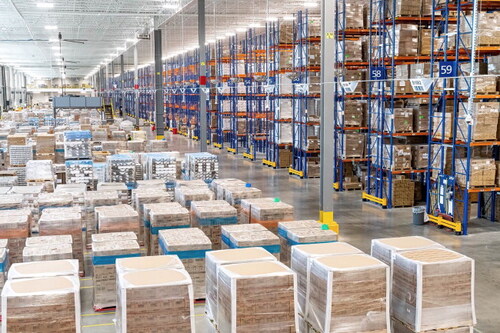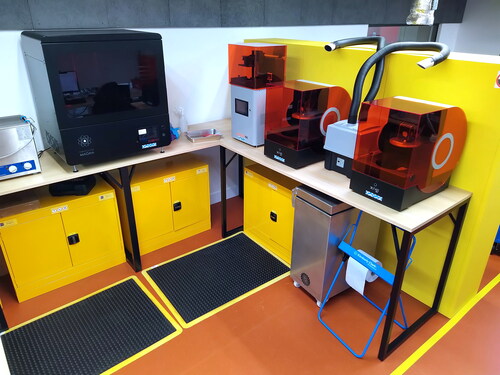THIRD-PARTY LOGISTICS (3PL) providers specialise in handling inventory for other firms. But back in 2013, Panalpina World Transport took part in a meeting at Cardiff University that would result in taking a whole new look at the way that stock is handled. Panalpina later became part of the DSV group (at the time of writing, the third largest 3PL firm in the world, with over 60,000 employees), but the Knowledge Transfer Partnerships established with Cardiff have continued to provide fresh Operational Research insights for the business.
Heading up the Cardiff side of the partnership is Aris Syntetos, Distinguished Research Professor of Operational Research and Operations Management and holder of the DSV Chair of Manufacturing and Logistics. After a first degree in business administration at the University of Piraeus (at the time, the Graduate School of Industrial Studies) in Athens, Aris went on to take an MSc in quality management at Stirling University, where forecasting became a particular interest for him, then a PhD in Operational Research at Brunel University. Now at Cardiff University, Aris heads up the PARC Institute of Manufacturing, Logistics and Inventory, based in the Cardiff Business School (CARBS) of Cardiff University. It was started with direct funding from Panalpina (hence the PAnalipina Research Centre) as a joint industry-university partnership. The initial interest was inventory forecasting.

The 3PL business is all about managing other companies’ inventories, but holding items in stock comes with a cost. The scale of this is brought home by the statistic that the total value of inventory in the US is equivalent to around 15 per cent of its gross domestic product. Traditionally, 3PL companies simply looked after whatever stock their clients requested, but the Cardiff partnership decided instead to look at ways to reduce the amount of inventory that was being held. This might seem counter-intuitive as a strategy for a 3PL company – effectively they were aiming to make things cheaper for their clients, hence reducing revenue – but this would improve service levels and make the company more attractive to potential customers.
AN END TO CONVENTIONAL INVENTORY?
Although forecasting was the reason DSV initially contacted the Cardiff team, the partnership soon came up with a more radical option. Would it be possible not to hold any inventory at all? This might seem to totally defeat the purpose of being a 3PL provider – but a new technology suggested that such an approach could be possible: 3D printing. Instead of taking up expensive storage space, holding for example spare parts, why not make use of this technology to make the parts to order, providing so-called distributed manufacturing?
There has been a long-established use of 3D printers in prototyping and design. These devices are a little like inkjet printers but rather than putting ink on paper, they deposit layer after layer of materials such as plastic or metal to build up what can be a complex three-dimensional structure. Inventory of consumables for the 3D printing would be miniscule in comparison to the inventory required for all the various parts. It is only relatively recently, however, that 3D printing has been seen as a potential part of production manufacturing – and it was an entirely novel approach to bring it into the logistics world. Fundamental to the technology’s wider use has been improvements in the hardware and software, which is seeing some print times falling from hours to minutes.
A key area with potential for stock reduction was spare parts inventory. Spares can often be slow moving stocks, where items have to be held for years or even decades, so provided an ideal focus for an attempt to replace inventory with on-demand manufacture – especially as spare parts are simpler to produce in this way than a complete product. A significant issue here proved to be end of life orders.
When a product is no longer being made, the manufacturer usually has to continue to provide spare parts for a number of years, both to cover warranty requirements and to enable customers to continue using the product for its expected lifetime. As Aris comments ‘This is a notoriously difficult problem as you need to be able to commit to providing spare parts for the next 5, 7, even 10 years. Either you end up with a lot of stock and you don’t know what to do with it, or you’re going to run out and not be able to meet contractual obligations. It was a key question: can we rely on 3D printing, instead of having to make this extremely difficult decision, which always leads to something going wrong?’
Aris works with CARBS, but the School of Engineering was also brought in to look at quality issues that were prevalent with 3D printing technologies, while the O.R. side (from CARBS) provided an analytical approach, modelling these novel forms of inventory management and their potential impact on stock holding costs. One particularly effective approach was to base employees from Panalpina (and later DSV) in the Cardiff centre, bringing both academic and practical expertise together.
The initial O.R. input was in the development of an inventory forecasting tool, which like subsequent solutions for DSV were put together in an Excel environment using Visual Basic, as the clients were familiar with the use of the spreadsheet, making the joint implementation of the tools developed this way more effective. Algorithms developed by Aris and his colleagues fed into the systems that the joint team would then use in practice. Forecasting was based on taking historical demand data along with associated inventory movements and using it to simulate the impact of alternative approaches.
an inventory forecasting tool [was] put together in an Excel environment using Visual Basic, as the clients were familiar with the use of the spreadsheet
As the idea of 3D printing took hold, a second venture was required to help with a key decision process. Not everything can be 3D printed. Existing 3D printing companies had already developed so called Printability Indices, which would give an online score for the effectiveness of 3D printing for a particular item, but these were relatively limited. The Cardiff team was able to make the approach more comprehensive and more suited to the particular model being used in the partnership with DSV and the specific technology available to them.
SMART OUTSOURCING
With 3D printing becoming a more significant part of the mix, yet another new way of working emerged. A 3D printing business can have significant spare capacity, which suggests the opportunity for outsourcing. As Aris notes ‘Traditionally this involved company A always having the opportunity to outsource to company B – but how about looking at having companies A and B developing a mutual arrangement, each outsourcing to the other as demand required?’ This so-called bidirectional partial outsourcing would give both parties greater flexibility. What’s more, the use of 3D printers, particularly with bidirectional outsourcing, also made possible a more distributed approach. Where 3PL companies have traditionally often needed to ship parts from country to country, localised 3D printers could reduce the shipping cost and the impact on the environment.
By 2015, Panalpina had a 3D printer operating at Eindhoven in the Netherlands. Spare capacity on the Panalpina printer was made available to Shapeways, a Dutch originated 3D printing company that has become well-established in the US. The Cardiff team used data from this experience to build a model for a number of companies outsourcing to each other in a network – a novel approach to supply chain modelling.
Whether working with DSV or providing direct support for businesses, the Cardiff centre has been able to help with a range of inventory requirements. A good example is Accolade Wines, a global wine business that has the largest wine warehouse and distribution centre in Europe. While bottles of wine aren’t yet available from 3D printers, the team has been able to improve the company’s production and inventory forecasting capabilities. Thanks to the Cardiff team’s algorithms, Accolade has been able to fundamentally change the way they calculate the safety stock levels needed to avoid running out of product.
According to Richard Lloyd, Accolade’s General Manager (European Operations & Supply Chain) ‘Whilst it is not possible to quantify the financial benefits of these changes there is no doubt that they have led to a distinct reduction in the amount of cash Accolade Wines has tied into inventory. The project has most certainly, directly and indirectly, positively impacted approximately 400 employees across the South of England.’ Similar assistance for Yeo Valley, the UK’s largest organic dairy producer, has, according to Managing Director Robert Saxton, provided stock holding and commercial opportunities that have led to ‘approximately £3m worth of cash and trading benefits.’
FEEDING THE CIRCULAR ECONOMY
Yet another new approach that has come out of the Cardiff work was to realise that the use of 3D printers to deal with end-of-life spare part requirements could be taken further to deal with broken products that previously would have to be discarded because there was no way to repair them. There is a lot of interest now in the circular economy: here, rather than discard defunct products, they are repaired or refurbished and brought back into use. In response, Cardiff has opened the RemakerSpace facility in its brand-new social sciences research park (SPARK).
Where 3D printers have traditionally been seen as part of the ‘maker space’, whether for design and prototyping or manufacturing, here a member of the public can come with something broken and a replacement part is designed, printed and used to fix the product, bringing it back into use. As with the other work of the partnership, DSV is now bringing the remaker concept into their portfolio to introduce their remaker services and make it more of a commercial proposition.
What the work of the PARC Centre has shown is the way that the Operational Research approach can enable companies to take a totally different look at their products and services. Former DSV Solutions Design Director, Andrew Lahy, commented that the Cardiff projects were ‘essential in implementing a vast number of changes within our organisation from a strategic level all the way down to the tactical level.’
assistance for Yeo Valley, the UK’s largest organic dairy producer, has, according to Managing Director Robert Saxton, provided stock holding and commercial opportunities that have led to ‘approximately £3m worth of cash and trading benefits’
According to Lahy, ‘one particular customer cut lead times down from 120 days to 20 days. This has had a hugely positive impact on their sales… customers now make more products locally and do not hold as much inventory due to the reduced lead times which has reduced waste.’ Finally, DSV has benefited from introducing 3D printing as a service. Lahy again: ‘The above changes have no doubt had a vast impact on the overall profit of the organisation. Prior to beginning our Knowledge Transfer Partnership projects with Cardiff University, Panalpina was losing 40 million euro per year. At the time of DSV buying Panalpina, and after implementing these changes, we were making 10 million euro per year which is an overall annual profit benefit of £50M.’
The above changes have no doubt had a vast impact on the overall profit of the organisation
Logistics is sometimes portrayed as a necessary but boring part of keeping a business in operation – but here, leading edge technology and smart thinking from the Cardiff team have transformed the way that inventory is handled.
Additional information
Notes on contributors
Brian Clegg
Brian Clegg is a science journalist and author and who runs the www.popularscience.co.uk and his own www.brianclegg.net websites. After graduating with a Lancaster University MA in Operational Research in 1977, Brian joined the O.R. Department at British Airways. He left BA in 1994 to set up a creativity training business. He is now primarily a science writer: his latest title Interstellar Tours explores the science you would experience on a starship tour of the Milky Way.





